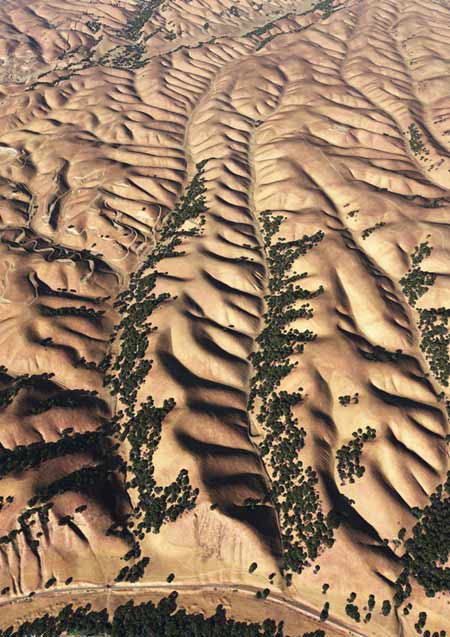Formula Found to Explain Earth's Evenly Spaced Valleys

Airplane passengers who like to gaze out at Earth's surface from the window seat have probably noticed this weird phenomenon — many valleys and ridges seem to be evenly spaced. Badlands National Park in South Dakota is a good example.
For decades, scientists have suspected that this strange but widespread regularity emerges from a geological tug-of-war between streams carving rock to create valleys and soil gradually creeping or falling downhill due to disturbances.
A new study by MIT geologist Taylor Perron and his colleagues has worked out a mathematical equation to describe this process and figure out which force is winning the tug-of-war — and by how much.
Their approach also allows them to predict the spacing between valleys and ridges. In fact, Perron and his colleagues tested their primary equation on five landscapes throughout the United States, and correctly predicted the valley and ridge spacings there. The sites included Gabilan Mesa and Napa Valley in the California Coast Ranges; the Dragon's Back pressure ridge along the San Andreas fault in the Carrizo Plain, California; Point of the Mountain in Salt Lake Valley, Utah; and Eaton Hollow in southwestern Pennsylvania.
In all five sites, the equal spacing between valleys is not a result of any structures in the underlying bedrock, such as fractures or faults. The sites comprise a range of rock types, including sandstones, siltstones, conglomerate rocks, and even coal, and have different kinds of vegetation.
{{ video="LS_090722_valley-spacing" title="The Evolution of Earth's Evenly Spaced Valleys" caption="The evolution is shown of a model landscape’s evenly spaced valleys over 600,000 years under the influence of bedrock uplift, stream incision and soil creep. See Perron et al., 2009, Nature." }}Perron said he was surprised to find that the mechanism controlling valley spacing is so simple. "It was like disassembling a complicated machine, only to discover that it's controlled by a single knob!" he told LiveScience.
How things even out
Sign up for the Live Science daily newsletter now
Get the world’s most fascinating discoveries delivered straight to your inbox.
Of course, valleys and ridges take many thousands of years to mature and space out. Initially, as stream channels start to erode into soil or rock, they form small valleys with irregular spacing, Perron said.
Slight differences in the initial topography from place to place cause some of these valleys to start out larger than — or spaced further from — their neighbors, he said. The larger valleys are able to capture more water and erode faster, which steals water from the smaller valleys, stunting their growth.
"Eventually most of the smaller valleys disappear entirely, leaving a few large valleys that are relatively evenly spaced," Perron said, adding that later in time, other valleys migrate laterally to close any remaining gaps, making the spacing even more uniform. Up to now, no theory had correctly predicted the fundamental topographic "wavelength" that emerges in natural landscapes due to the pattern of valleys and ridges, he said. Why Badlands have narrow spacing The specifics of the new equation, detailed in the July 23 issue of the journal Nature and devised by Perron along with James Kirchner and William Dietrich of the University of California, Berkeley, measure the competition between the mechanisms involved in stream carving (or stream incision) and valley-filling. Along with enabling predictions of what the valley spacing should be in various locations, the equation also shows that you get wider spacing between valleys when soil creep is stronger relative to the carving work done by stream incision — all the small valleys get filled in. Whereas, stronger stream carving relative to valley-filling yields narrowly spaced valleys, as in the Badlands. The main force that makes soil creep downslope and end up filling Earth's valleys might be surprising to some. Soil creep is primarily the result of animals that burrow and thereby disturb the soil, Perron said. Research shows that while rock is weathered by precipitation and chemical breakdown to create soil, the soil itself is moved downslope in many landscapes primarily by the activity of small animals, such as gophers and squirrels, Perron said. Exceptions include landscapes with little vegetation, some high-elevation and high-latitude sites, and deserts, where wind transports sand. Exceptions Not all valleys and ridges on Earth are evenly spaced, as anyone can see. These are typically landscapes with variable rock strength and structure, or geologically young landscapes where the valleys haven't had time yet to even out their spacing, Perron said.
In the long run, the new finding is part of Perron's efforts to learn how patterns in landscapes record the combined effects of climate, tectonics and life on Earth's surface. In fact, valley spacing may be a clue to aspects of a site's geological past and the influences of climate there that might otherwise be invisible, he said.
The research was supported by the National Science Foundation, Institute for Geophysics and Planetary Physics and NASA.
- Video - The Evolution of Earth's Evenly Spaced Valleys
- Gallery: Earth from Above
- 101 Amazing Earth Facts
Robin Lloyd was a senior editor at Space.com and Live Science from 2007 to 2009. She holds a B.A. degree in sociology from Smith College and a Ph.D. and M.A. degree in sociology from the University of California at Santa Barbara. She is currently a freelance science writer based in New York City and a contributing editor at Scientific American, as well as an adjunct professor at New York University's Science, Health and Environmental Reporting Program.










